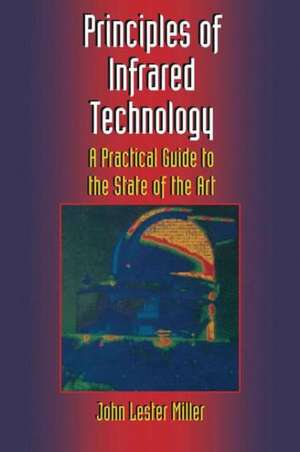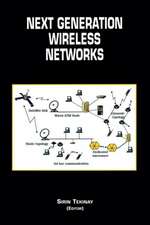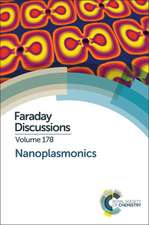Principles of Infrared Technology: A Practical Guide to the State of the Art
Autor John Lester Milleren Limba Engleză Paperback – 14 apr 2012
| Toate formatele și edițiile | Preț | Express |
|---|---|---|
| Paperback (1) | 957.32 lei 6-8 săpt. | |
| Springer Us – 14 apr 2012 | 957.32 lei 6-8 săpt. | |
| Hardback (1) | 1235.76 lei 6-8 săpt. | |
| Springer Us – 30 mai 1994 | 1235.76 lei 6-8 săpt. |
Preț: 957.32 lei
Preț vechi: 1167.45 lei
-18% Nou
Puncte Express: 1436
Preț estimativ în valută:
183.21€ • 190.56$ • 151.25£
183.21€ • 190.56$ • 151.25£
Carte tipărită la comandă
Livrare economică 15-29 aprilie
Preluare comenzi: 021 569.72.76
Specificații
ISBN-13: 9781461576662
ISBN-10: 1461576660
Pagini: 596
Ilustrații: 624 p.
Dimensiuni: 152 x 229 x 31 mm
Greutate: 0.79 kg
Ediția:Softcover reprint of the original 1st ed. 1994
Editura: Springer Us
Colecția Springer
Locul publicării:New York, NY, United States
ISBN-10: 1461576660
Pagini: 596
Ilustrații: 624 p.
Dimensiuni: 152 x 229 x 31 mm
Greutate: 0.79 kg
Ediția:Softcover reprint of the original 1st ed. 1994
Editura: Springer Us
Colecția Springer
Locul publicării:New York, NY, United States
Public țintă
ResearchDescriere
This book is about general infrared (IR) engineering, technology, practices, and principles as they apply to modem imaging systems. An alternative title to this book with appeal to managers and marketing personnel might be "Everything You Always Wanted to Know about Infrared Sensors, but Couldn't Get Answers on from Engineers." This book is not meant to be a comprehensive compendium of IR (like the Infrared and Electro Optical Systems Handbook). Rather, it is intend ed to complement such texts by providing up to date information and pragmatic knowledge that is difficult to locate outside of periodicals. The information contained in this book is critical in the day-to-day life of en gineering practitioners, proposal writers, and those on the periphery of an IR pro gram. It serves as a guide for engineers wishing to "catch up," engineers new to the field, managers, students, administrators, and technicians. It is also useful for seasoned IR engineers who want to review recent technological developments.
Cuprins
I Management.- 1 The Challenge for Infrared Technology.- 1.1 The Challenge.- 1.2 The Market Environment.- 1.3 The Impact of Component Technology Advances.- 1.4 How to Get There from Here.- 1.5 Conclusion.- References.- 2 Management of Electro-Optics.- 2.1 Introduction.- 2.2 Organizational Issues.- 2.3 Symbol Confusion.- 2.4 Applications of Fad Management.- 2.5 Management Margins.- 2.6 Monitoring Progress.- 2.7 Capital Equipment and Facilities.- 2.8 Price/Cost Estimation.- 2.9 Selecting and Managing Subcontractors.- 2.10 Conclusion.- References.- II Component Technologies.- 3 Infrared Telescopes.- 3.1 Technology Basics.- 3.2 Coatings and Filters.- 3.3 Refractive IR Optics.- 3.4 Reflective Optics.- 3.5 Diffractive IR Optics.- 3.6 Advanced Material Metering Structures.- 3.7 Weight Estimation.- 3.8 Cost Estimation.- References.- Appendix 3A.- 4 Focal Plane Arrays.- 4.1 Technology Basics.- 4.2 Mercury Cadmium Telluride.- 4.3 Indium Gallium Arsenide Family.- 4.4 Lead Salts.- 4.5 Schottky Barriers.- 4.6 Indium Antimonide.- 4.7 Quantum Wells.- 4.8 Doped Silicon.- 4.9 Bolometric Arrays.- 4.10 Superconductors.- 4.11 Pyroelectrics.- References.- Appendix 4A.- 5 Cryocooling Systems.- 5.1 Technology Basics.- 5.2 Thermo-Electric Coolers.- 5.3 Joule-Thomson (Blow-Down) Systems.- 5.4 Stirling Refrigerators.- 5.5 Other Closed-Cycle Cryocoolers.- 5.6 Radiators.- References.- Appendix 5A.- 6 Image and Signal Processors.- 6.1 Technology Basics.- 6.2 Signal and Image Processing Functions and Techniques.- 6.3 Fusion.- 6.4 Signal Processing with Conventional ICs.- 6.5 Parallel Machines.- 6.6 Z-Planes.- 6.7 Neural Net Applications.- 6.8 Miscellaneous Hardware Advancements.- References.- Appendix 6A.- 7 Pointing, Scanning, and Stabilization Mechanisms.- 7.1 Technology Basics.- 7.2 Fast Steering/Stabilization Mirrors.- 7.3 Object Space Gimbals.- 7.4 Scanning Systems.- 7.5 Active/Adaptive Optics.- References.- Appendix 7A.- III Systems.- 8 General-Purpose/Ground-Based IR Cameras.- 8.1 Technology Basics.- 8.2 Environments.- 8.3 Targets and Backgrounds.- 8.4 Figures of Merit.- 8.5 Component Considerations.- 8.6 System Considerations.- References.- Appendix 8A.- 9 Smart Weapon Seekers.- 9.1 Technology Basics.- 9.2 Environments.- 9.3 Targets and Backgrounds.- 9.4 Figures of Merit.- 9.5 Component Considerations.- 9.6 System Considerations.- References.- Appendix 9A.- 10 FLIRs and IRSTs.- 10.1 Technology Basics.- 10.2 Environments.- 10.3 Targets and Backgrounds.- 10.4 Figures of Merit.- 10.5 Component Considerations.- 10.6 System Considerations.- References.- Appendix 10A.- 11 Space-Based Sensors.- 11.1 Technology Basics.- 11.2 Environments.- 11.3 Targets and Backgrounds.- 11.4 Figures of Merit.- 11.5 Component Concerns.- 11.6 System Considerations.- References.- Appendix 11A.- 12 Weather and Environmental Monitoring Sensors.- 12.1 Introduction.- 12.2 Environments.- 12.3 Targets and Backgrounds.- 12.4 Figures of Merit.- 12.5 System Effects of Components.- 12.6 System Drivers.- References.- Appendix 12A.- Appendix A: Nomenclature.- Appendix B: Glossary.- Abbreviations, Acronyms, and Symbols.- Definitions.- Appendix C: Bibliography.






















